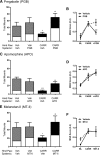Pain reduces sexual motivation in female but not male mice
- PMID: 24760835
- PMCID: PMC3996207
- DOI: 10.1523/JNEUROSCI.5337-13.2014
Pain reduces sexual motivation in female but not male mice
Abstract
Chronic pain is often associated with sexual dysfunction, suggesting that pain can reduce libido. We find that inflammatory pain reduces sexual motivation, measured via mounting behavior and/or proximity in a paced mating paradigm, in female but not male laboratory mice. Pain was produced by injection of inflammogens zymosan A (0.5 mg/ml) or λ-carrageenan (2%) into genital or nongenital (hind paw, tail, cheek) regions. Sexual behavior was significantly reduced in female mice experiencing pain (in all combinations); male mice similarly treated displayed unimpeded sexual motivation. Pain-induced reductions in female sexual behavior were observed in the absence of sex differences in pain-related behavior, and could be rescued by the analgesic, pregabalin, and the libido-enhancing drugs, apomorphine and melanotan-II. These findings suggest that the well known context sensitivity of the human female libido can be explained by evolutionary rather than sociocultural factors, as female mice can be similarly affected.
Keywords: motivation; paced mating; pain; sex difference; sexual behavior.
Figures


References
Publication types
MeSH terms
Substances
Grants and funding
LinkOut - more resources
Full Text Sources
Other Literature Sources
Medical
